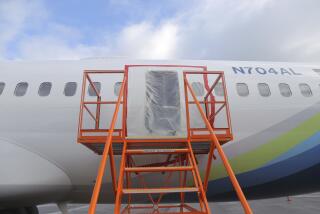Recline rage: Why airline seating is provoking mid-flight fights
For the third time in about a week, aisle rage erupted on Monday after a dispute over a reclined seat led a Delta flight to make an unscheduled stop. One passenger was taken off of the plane in Jacksonville, Fla., and the aircraft then completed its New York to West Palm Beach, Fla., trip, arriving about 90 minutes late.
If this had been a single event, few people outside of those delayed would have been concerned. But the incident seems to be the latest in a pattern of anger over seating space that has turned the once friendly skies into a 21st century version of the old college game about how many football players can fit into a Volkswagen.
According to Delta, Flight 2370 left New York’s LaGuardia Airport about 7 p.m.
A passenger on the flight, Aaron Klipin, told reporters in Florida that another passenger got into an argument with a woman sitting a row ahead who wanted to recline her seat so she could knit. The passenger behind was trying to nap on a tray table and began screaming at the woman to put up the seat. Eventually, the unruly passenger demanded that the flight be diverted and the crew complied.
“Out of an abundance of caution, the captain elected to divert to the closest airport,” Delta said in a statement released to the media. “Local law enforcement met the flight and removed the passenger.”
On Aug. 27, a American Airlines Miami-to-Paris flight was rerouted to Boston after two undercover air marshals had to restrain a 61-year-old man, one of two passengers who scuffled when one of them attempted to recline the seat. On Aug. 24, a fight started on a United Airlines flight when a male passenger used a Knee Defender, a $21 gadget designed to prevent the person in front from reclining. That New Jersey-to-Denver flight was diverted to Chicago, and both of the passengers were ordered off the plane.
The latest disputes come as airlines have been decreasing the amount of space available for passengers, cramming smaller seats more tightly into rows to increase income. They have also been demanding passengers pay a range of fees for baggage and upgrades to seats with more legroom. Not surprisingly, many airlines recently announced record profits for the second quarter.
According to Independenttraveler.com, the standard airline seat once had 33 to 34 inches of room between a seat and the one in front. That measurement, known as the pitch, has fallen in many airlines to about 31 inches.
The width of individual seats can also vary. Many first-class seats run about 21 inches wide, about the same size as a typical Amtrak train seat, but still smaller than many movie seats.
However, seats in economy are just 17 inches wide. Airlines thus are able to put more seats in each row, so that the coach section not only feels more cramped, it looks like a sardine can. For example, the standard setup in the back of a Boeing was nine seats per row. But last year, nearly 70% of the inventory of the biggest version of the plane was delivered with 10-abreast seating, up from just 15% in 2010, the Wall Street Journal reported in 2013.
The bottom line is that size does indeed matter and the airlines are trying to capitalize. To ease the overall crunch, many airlines will sell passengers a few extra inches of space. Virgin Atlantic, for example, offers an extra three inches of legroom for an extra $60 -- one way.
So unless you pay for extra space, be prepared to love your seatmates like yourself -- or face the consequences.
Follow @latimesmuskal on Twitter for national news.
More to Read
Start your day right
Sign up for Essential California for news, features and recommendations from the L.A. Times and beyond in your inbox six days a week.
You may occasionally receive promotional content from the Los Angeles Times.







